Ever since we began sending crewed missions to the Moon, people have been dreaming of the day when we might one day colonize it. Just imagine, a settlement on the lunar surface, where everyone constantly feels only about 15% as heavy as they do here on Earth. And in their spare time, the colonists get to do all kinds of cool research trek across the surface in lunar rovers. Gotta admit, it sounds fun!
More recently, the idea of prospecting and mining on the Moon has been proposed. This is due in part to renewed space exploration, but also the rise of private aerospace companies and the NewSpace industry. With missions to the Moon schedules for the coming years and decades, it seems logical to thinking about how we might set up mining and other industries there as well?
Proposed Methods:
Several proposals have been made to establish mining operations on the Moon; initially by space agencies like NASA, but more recently by private interests. Many of the earliest proposals took place during the 1950s, in response to the Space Race, which saw a lunar colony as a logical outcome of lunar exploration.
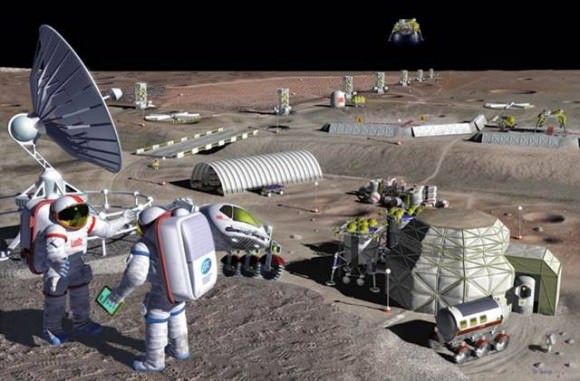
For instance, in 1954 Arthur C. Clarke proposed a lunar base where inflatable modules were covered in lunar dust for insulation and communications were provided by a inflatable radio mast. And in 1959, John S. Rinehart – the director of the Mining Research Laboratory at the Colorado School of Mines – proposed a tubular base that would “float” across the surface.
Since that time, NASA, the US Army and Air Force, and other space agencies have issued proposals for the creation of a lunar settlement. In all cases, these plans contained allowances for resource utilization to make the base as self-sufficient as possible. However, these plans predated the Apollo program, and were largely abandoned after its conclusion. It has only been in the past few decades that detailed proposals have once again been made.
For instance, during the Bush Administration (2001-2009), NASA entrtained the possibility of creating a “lunar outpost”. Consistent with their Vision for Space Exploration (2004), the plan called for the construction of a base on the Moon between 2019 and 2024. One of the key aspects of this plan was the use of ISRU techniques to produce oxygen from the surrounding regolith.
These plans were cancelled by the Obama administration and replaced with a plan for a Mars Direct mission (known as NASA’s “Journey to Mars“). However, during a workshop in 2014, representatives from NASA met with Harvard geneticist George Church, Peter Diamandis from the X Prize Foundation and other experts to discuss low-cost options for returning to the Moon.
The workshop papers, which were published in a special issue of New Space, describe how a settlement could be built on the Moon by 2022 for just $10 billion USD. According to their papers, a low-cost base would be possible thanks to the development of the space launch business, the emergence of the NewSpace industry, 3D printing, autonomous robots, and other recently-developed technologies.
In December of 2015, an international symposium titled “Moon 2020-2030 – A New Era of Coordinated Human and Robotic Exploration” took place at the the European Space Research and Technology Center. At the time, the new Director General of the ESA (Jan Woerner) articulated the agency’s desire to create an international lunar base using robotic workers, 3D printing techniques, and in-situ resources utilization.
In 2010, NASA established the Robotic Mining Competition, an annual incentive-based competition where university students design and build robots to navigate a simulated Martian environment. One of the most-important aspects of the competition is creating robots that can rely on ISRU to turn local resources into usable materials. The applications produced are also likely to be of use during future lunar missions.
Other space agencies also have plans for lunar bases in the coming decades. The Russian space agency (Roscosmos) has issued plans to build a lunar base by the 2020s, and the China National Space Agency (CNSA) proposed to build such a base in a similar timeframe, thanks to the success of its Chang’e program.
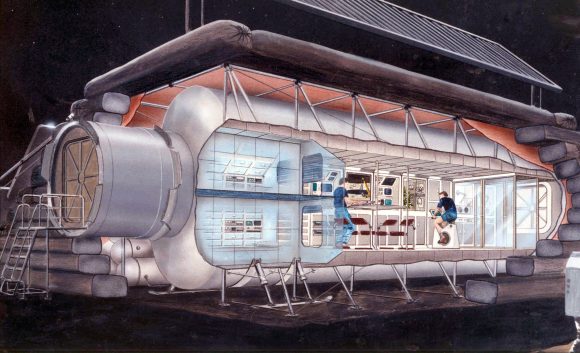
And the NewSpace industry has also been producing some interesting proposals of late. In 2010, a group of Silicon Valley entrepreneurs came together for create Moon Express, a private company that plans to offer commercial lunar robotic transportation and data services, as well as the a long-term goal of mining the Moon. In December of 2015, they became the first company competing for the Lunar X Prize to build and test a robotic lander – the MX-1.
In 2010, Arkyd Astronautics (renamed Planetary Resources in 2012) was launched for the purpose of developing and deploying technologies for asteroid mining. In 2013, Deep Space Industries was formed with the same purpose in mind. Though these companies are focused predominantly on asteroids, the appeal is much the same as lunar mining – which is expanding humanity’s resource base beyond Earth.
Resources:
Based on the study of lunar rocks, which were brought back by the Apollo missions, scientists have learned that the lunar surface is rich in minerals. Their overall composition depends on whether the rocks came from lunar maria (large, dark, basaltic plains formed from lunar eruptions) or the lunar highlands.
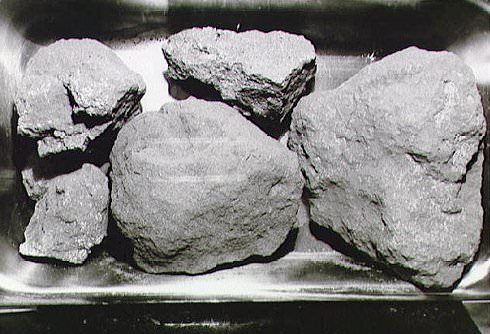
Rocks obtained from lunar maria showed large traces of metals, with 14.9% alumina (Al²O³), 11.8% calcium oxide (lime), 14.1% iron oxide, 9.2% magnesia (MgO), 3.9% titanium dioxide (TiO²) and 0.6% sodium oxide (Na²O). Those obtained from the lunar highlands are similar in composition, with 24.0% alumina, 15.9% lime, 5.9% iron oxide, 7.5% magnesia, and 0.6% titanium dioxide and sodium oxide.
These same studies have shown that lunar rocks contain large amounts of oxygen, predominantly in the form of oxidized minerals. Experiments have been conducted that have shown how this oxygen could be extracted to provide astronauts with breathable air, and could be used to make water and even rocket fuel.
The Moon also has concentrations of Rare Earth Metals (REM), which are attractive for two reasons. On the one hand, REMs are becoming increasingly important to the global economy, since they are used widely in electronic devices. On the other hand, 90% of current reserves of REMs are controlled by China; so having a steady access to an outside source is viewed by some as a national security matter.
Similarly, the Moon has significant amounts of water contained within its lunar regolith and in the permanently shadowed areas in its north and southern polar regions.This water would also be valuable as a source of rocket fuel, not to mention drinking water for astronauts.
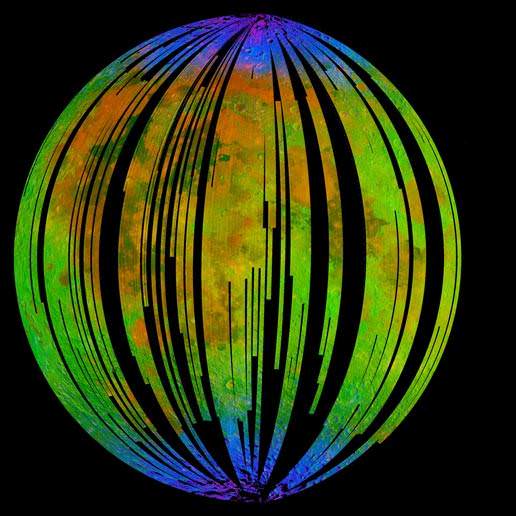
In addition, lunar rocks have revealed that the Moon’s interior may contain significant sources of water as well. And from samples of lunar soil, it is calculated that adsorbed water could exist at trace concentrations of 10 to 1000 parts per million. Initially, it was though that concentrations of water within the moon rocks was the result of contamination.
But since that time, multiple missions have not only found samples of water on the lunar surface, but revealed evidence of where it came from. The first was India’s Chandrayaan-1 mission, which sent an impactor to the lunar surface on Nov. 18th, 2008. During its 25-minute descent, the impact probe’s Chandra’s Altitudinal Composition Explorer (CHACE) found evidence of water in the Moon’s thin atmosphere.
In March of 2010, the Mini-RF instrument on board Chandrayaan-1 discovered more than 40 permanently darkened craters near the Moon’s north pole that are hypothesized to contain as much as 600 million metric tonnes (661.387 million US tons) of water-ice.
In November 2009, the NASA LCROSS space probe made similar finds around the southern polar region, as an impactor it sent to the surface kicked up material shown to contain crystalline water. In 2012, surveys conducted by the Lunar Reconnaissance Orbiter (LRO) revealed that ice makes up to 22% of the material on the floor of the Shakleton crater (located in the southern polar region).
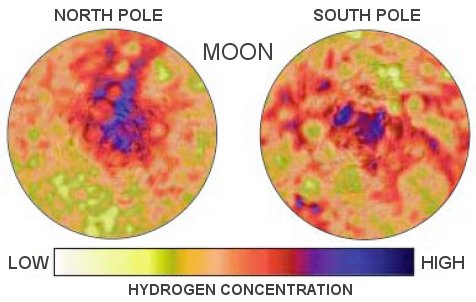
It has been theorized that all this water was delivered by a combination of mechanisms. For one, regular bombardment by water-bearing comets, asteroids and meteoroids over geological timescales could have deposited much of it. It has also been argued that it is being produced locally by the hydrogen ions of solar wind combining with oxygen-bearing minerals.
But perhaps the most valuable commodity on the surface of the Moon might be helium-3. Helium-3 is an atom emitted by the Sun in huge amounts, and is a byproduct of the fusion reactions that take place inside. Although there is little demand for helium-3 today, physicists think they’ll serve as the ideal fuel for fusion reactors.
The Sun’s solar wind carries the helium-3 away from the Sun and out into space – eventually out of the Solar System entirely. But the helium-3 particles can crash into objects that get in their way, like the Moon. Scientists haven’t been able to find any sources of helium-3 here on Earth, but it seems to be on the Moon in huge quantities.
Benefits:
From a commercial and scientific point of view, there are several reasons why Moon mining would be beneficial to humanity. For starters, it would be absolutely essential to any plans to build a settlement on the Moon, as in-situ resource utilization (ISRU) would be far more cost effective than transporting materials from Earth.
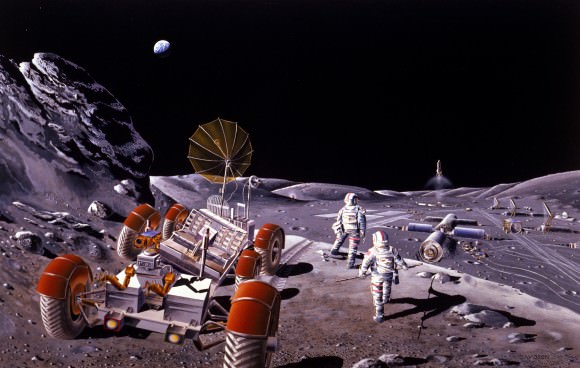
Also, it is predicted that the proposed space exploration efforts for the 21st century will require large amounts of materiel. That which is mined on the Moon would be launched into space at a fraction of the cost of what is mined here on Earth, due to the Moon’s much lower gravity and escape velocity.
In addition, the Moon has an abundance of raw materials that humanity relies on. Much like Earth, it is composed of silicate rocks and metals that are differentiated between a geochemically distinct layers. These consist of is iron-rich inner core, and iron-rich fluid outer core, a partially molten boundary layer, and a solid mantle and crust.
In addition, it has been recognized for some time that a lunar base – which would include resource operations – would be a boon for missions farther into the Solar System. For missions heading to Mars in the coming decades, the outer Solar System, or even Venus and Mercury, the ability to be resupplied from an lunar outpost would cut the cost of individual missions drastically.
Challenges:
Naturally, the prospect of setting up mining interests on the Moon also presents some serious challenges. For instance, any base on the Moon would need to be protected from surface temperatures, which range from very low to high – 100 K (-173.15 °C;-279.67 °F) to 390 K (116.85 °C; 242.33 °F) – at the equator and average 150 K (-123.15 °C;-189.67 °F) in the polar regions.
![Schematic showing the stream of charged hydrogen ions carried from the Sun by the solar wind. One possible scenario to explain hydration of the lunar surface is that during the daytime, when the Moon is exposed to the solar wind, hydrogen ions liberate oxygen from lunar minerals to form OH and H2O, which are then weakly held to the surface. At high temperatures (red-yellow) more molecules are released than adsorbed. When the temperature decreases (green-blue) OH and H2O accumulate. [Image courtesy of University of Maryland/F. Merlin/McREL]](https://www.universetoday.com/wp-content/uploads/2009/09/water-on-the-moon.jpg)
Then there’s the Moon dust, which is an extremely abrasive glassy substance that has been formed by billions of years of micrometeorite impacts on the surface. Due to the absence of weathering and erosion, Moon dust is unrounded and can play havoc with machinery, and poses a health hazard. Worst of all, its sticks to everything it touches, and was a major nuisance for the Apollo crews!
And while the lower gravity is attractive as far as launches are concerned, it is unclear what the long-term health effects of it will be on humans. As repeated research has shown, exposure to zero-gravity over month-long periods causes muscular degeneration and loss of bone density, as well as diminished organ function and a depressed immune system.
In addition, there are the potential legal hurdles that lunar mining could present. This is due to the “The Treaty on Principles Governing the Activities of States in the Exploration and Use of Outer Space, including the Moon and Other Celestial Bodies” – otherwise known as “The Outer Space Treaty”. In accordance with this treaty, which is overseen by the United Nations Office for Outer Space Affairs, no nation is permitted to own land on the Moon.
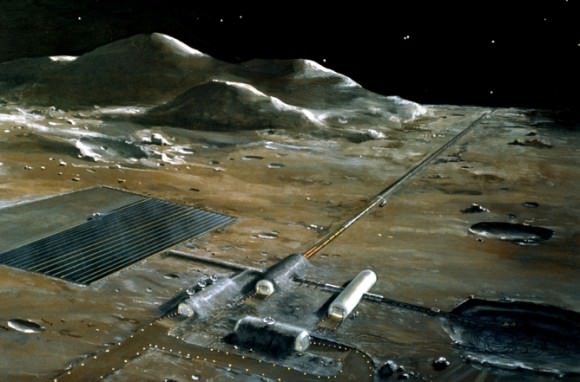
And while there has been plenty of speculation about a “loophole” which does not expressly forbid private ownership, there is no legal consensus on this. As such, as lunar prospecting and mining become more of a possibility, a legal framework will have to be worked out that ensures everything is on the up and up.
Though it might be a long way off, it is not unreasonable to think that someday, we could be mining the Moon. And with its rich supplies of metals (which includes REMs) becoming part of our economy, we could be looking at a future characterized by post-scarcity!
We have written many articles on Moon mining and colonization here at Universe Today. Here’s Who Were the First Men on the Moon?, What were the First Lunar Landings?, How Many People have Walked on the Moon?, Can you Buy Land on the Moon?, and Building A Space Base, Part 1: Why Mine On The Moon Or An Asteroid?
For more information, be sure to check out this infographic on Moon Mining from NASA’s Jet Propulsion Laboratory.
Astronomy Cast also has some interesting episodes on the subject. Listen here – Episode 17: Where Did the Moon Come From? and Episode 113: The Moon – Part I.
Sources:

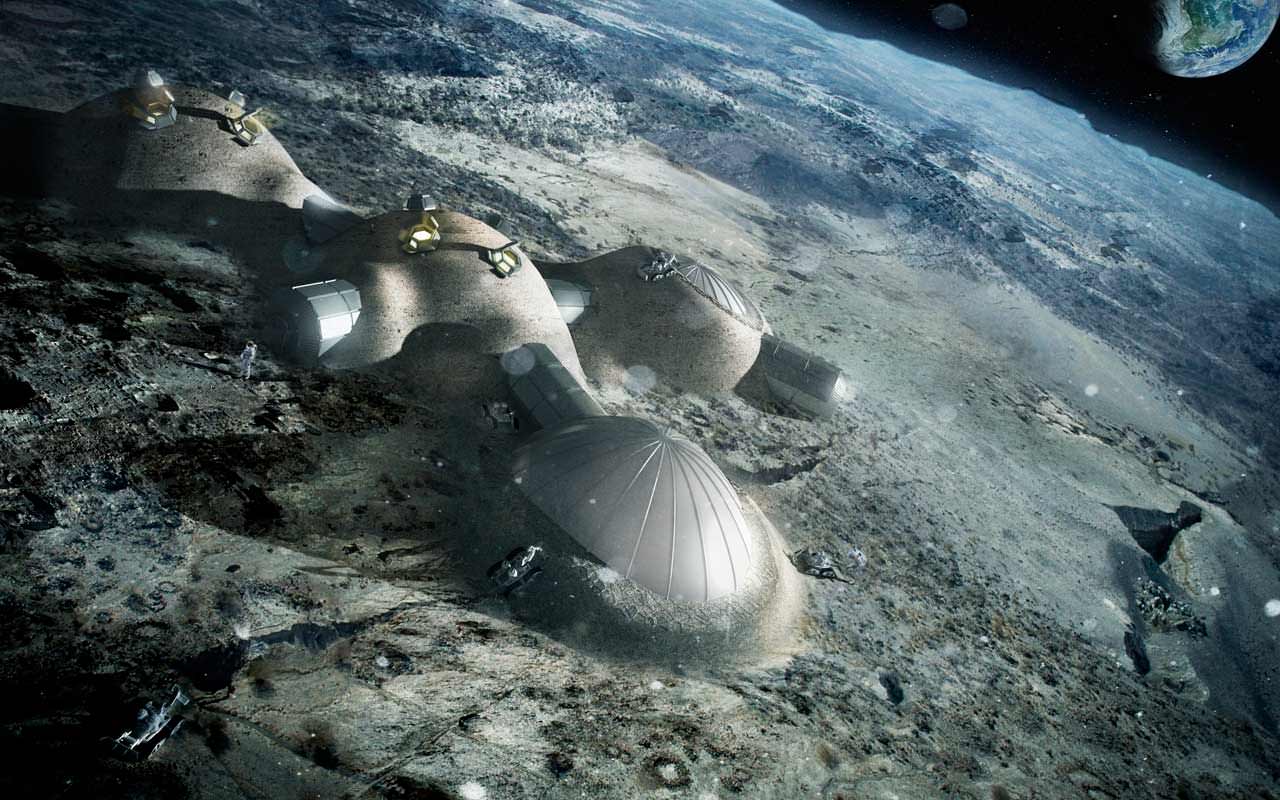
The extreme lunar temperature swings aren’t as much of an issue at the lunar poles. Neighboring the ice rich crater floors at the poles are plateaus that enjoy nearly constant sunlight. The temperature in these locations is -50º centigrade plus or minus ten degrees.
This seems like it’s very cold but vacuum is a good insulator. If a lunar base is established at these sunlit plateaus, it may be more of problem to dump waste heat than to keep warm.
You have to remember that you can not take huge/massive amounts of material from the moon and you can not add massive amounts of material either
All dwellings should be made out of material on the moon first and formost
because the moon is in a gravatational dance with the earth and other planetary bodies and it is based on its mass and to change it one way or the other will distrupt that balance of nature.
A ton here and a ton there not so much but since the moon is gravity locked you have to plan any thing accordingly to its tragectory.
And time travel too?
“In December of 2016, an international symposium titled “Moon 2020-2030 – A New Era of Coordinated Human and Robotic Exploration” took place at the the European Space Research and Technology Center.”
Here we go again!
How did Universe Today team get their time machine?
“In December of 2016, they became the first company competing for the Lunar X Prize to build and test a robotic lander – the MX-1.